小学英语教案格式
小学英语教育教学教案设计(精选9篇)

小学英语教育教学教案设计(精选9篇)(经典版)编制人:__________________审核人:__________________审批人:__________________编制单位:__________________编制时间:____年____月____日序言下载提示:该文档是本店铺精心编制而成的,希望大家下载后,能够帮助大家解决实际问题。
文档下载后可定制修改,请根据实际需要进行调整和使用,谢谢!并且,本店铺为大家提供各种类型的经典范文,如总结报告、心得体会、应急预案、会议记录、条据书信、合同协议、规章制度、教学资料、作文大全、其他范文等等,想了解不同范文格式和写法,敬请关注!Download tips: This document is carefully compiled by this editor. I hope that after you download it, it can help you solve practical problems. The document can be customized and modified after downloading, please adjust and use it according to actual needs, thank you!Moreover, our store provides various types of classic sample essays, such as summary reports, insights, emergency plans, meeting minutes, evidence letters, contract agreements, rules and regulations, teaching materials, essay summaries, and other sample essays. If you would like to learn about different sample formats and writing methods, please pay attention!小学英语教育教学教案设计(精选9篇)小学英语教育教学教案设计(精选9篇)2024-04-14 12:07:23小学英语教学设计(精选6篇)推荐度:小学英语教学设计范文最新6篇推荐度:热点范文英语(英文:English)是一种西日耳曼语支,最早被中世纪的英国使用,并因其广阔的殖民地而成为世界使用面积最广的语言。
小学英语优秀教案范文模板模板
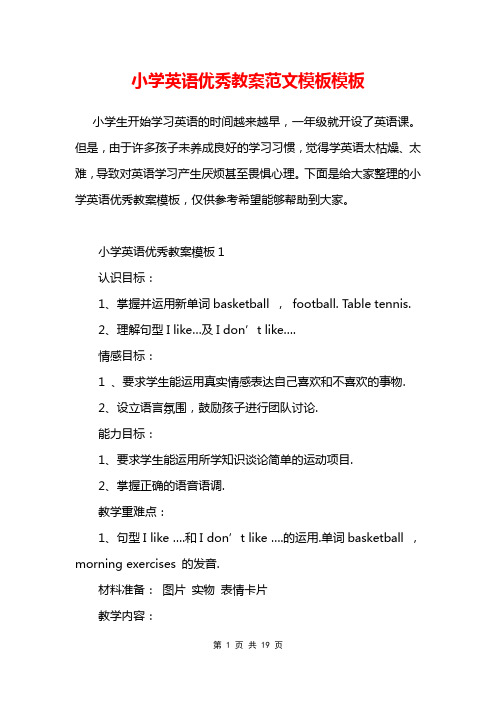
小学英语优秀教案范文模板模板小学生开始学习英语的时间越来越早,一年级就开设了英语课。
但是,由于许多孩子未养成良好的学习习惯,觉得学英语太枯燥、太难,导致对英语学习产生厌烦甚至畏惧心理。
下面是给大家整理的小学英语优秀教案模板,仅供参考希望能够帮助到大家。
小学英语优秀教案模板1认识目标:1、掌握并运用新单词basketball ,football. Table tennis.2、理解句型I like…及I don’t like….情感目标:1 、要求学生能运用真实情感表达自己喜欢和不喜欢的事物.2、设立语言氛围,鼓励孩子进行团队讨论.能力目标:1、要求学生能运用所学知识谈论简单的运动项目.2、掌握正确的语音语调.教学重难点:1、句型I like ….和I don’t like ….的运用.单词basketball ,morning exercises 的发音.材料准备:图片实物表情卡片教学内容:Language :I like …. I don’t like….Vocabulary:football、basketball、table tennis教学过程:一、Warm up :Morning exercises (预备环节活跃气氛复习单词exercises) Clap your hands ,tap your feet ,shake your hand .二、Vacabulary:T:On the board draw a ball. “ What’s this ?”S:It’s a ball. (本环节是共同的基础,引出新课)Then show the picture of football.Practice:read after the teacher. (分男女生进行比赛练习,单词练习)三、Game:This is football.(击鼓传球,句子练习,增强趣味性)老师用投篮的动作引出basketball ,辅助图片加深印象.T:What’s this ?S:This is a basketball.Line by line :This is a basketball.Language :I like ….用Do you like basketball ?老师将一个happy face 放在football的图片下,引出I like football .同理练习I like basketball. (跟读,比赛练习巩固)Game:What did teacher says ? (用实物以加深认识)Vacabulary :用实物呈现table tennis. 待学生熟悉单词后加入句子练习“I like table tennis.”Teacher play the table tennis :Look,oh no ,I don’t like table tennis.同时,将sad face放在table tennis 的图片下.T:Don’t. I don’t like table tennis.四、Practice:分别用happy face 和sad face 进行说话练习.(能力练习,加强孩子的语言组织能力)Extra activities:(Children all stand up then walk in a circle.)T:Let’s play basketball / football / table tennis .S:( Repeat and do the actions.) (此环节是对下面内容的铺垫)示范:请1个小朋友.T :Let’s play football. Ok?S:Ok,I like football.Make a dialogue. (更高一层的要求,培养孩子的综合能力)S1:Let’s play football . Ok ?S2:No. I don’t like football.S1:Let’s play basketball.S2:Ok. I like basketball.小学英语优秀教案模板2一、教材分析:本单元的重点学习内容之一是12个月份的名称,包括了听说认读。
小学英语教案模板(5篇)

小学英语教案模板(5篇)最新小学英语教案模板(5篇)初步了解表示接触的指示用语,能听懂,并按指令做出相应的动作。
你会写教案吗?下面是小编为大家整理的最新小学英语教案模板,希望能够帮助到大家!最新小学英语教案模板篇1教学目标:知识与能力:1、能听懂、会说“How tall are you I’m 1.65meters. I’m taller than this one. Howtall is it”并能在情景中正确运用。
2、能够知道meter的意思能够独立完成let’s try的练习过程与方法:学生能在合作交流中使用新语言进行沟通情感与价值观:培养学生良好的英语学习习惯。
了解基本的计量单位的运用教学重点:掌握句型:How tall are you I’m 1.65meters. I’m taller than this one. How tallis it”教学难点:能在情景中正确运用所学句型并能完成调查表。
教具学具课件准备录音机及磁带、图片、学生自备一张调查表第几课时:2探索流程个性添加(教学反思)1. preparation(预习)1.日常口语练习。
2.复习单词:taller、 longer、 older、 younger 、shorter2. presentation(新课呈现)(1)Let’s try教师播放录音,学生独立完成练习并核对答案(2)Let’s talka.生阅读对话,并解释大意b.教师范读,学生跟读c.分组读,个别读回答问题d.播放录音,学到再次跟读3.practice(练习)(1).T: How tall are you I’m 1.65metres.引导学生回答,并多加练习。
(2).做完后教师出示图片问How tall are you请学生轮流回答。
(3).把图片出示给学生,让他们加强练习。
同桌或小组之间互相练习。
(4).学生两人分角色朗读课文对话。
4.homework(家庭拓展)(1).做本单元A Let’s talk部分的活动手册配套练习。
小学英文教案模板
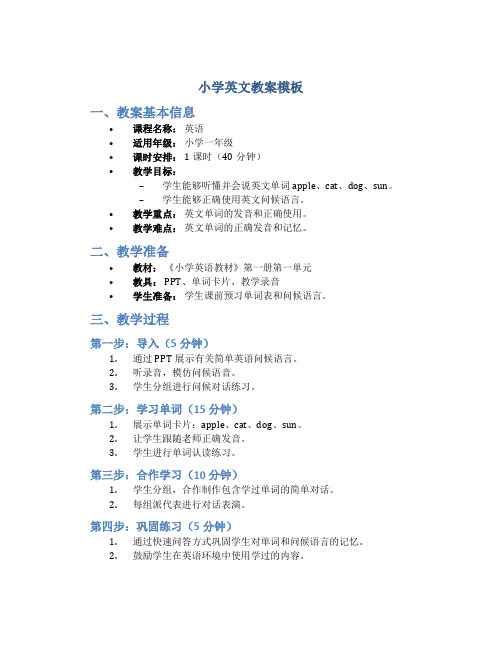
小学英文教案模板一、教案基本信息•课程名称:英语•适用年级:小学一年级•课时安排: 1课时(40分钟)•教学目标:–学生能够听懂并会说英文单词apple、cat、dog、sun。
–学生能够正确使用英文问候语言。
•教学重点:英文单词的发音和正确使用。
•教学难点:英文单词的正确发音和记忆。
二、教学准备•教材:《小学英语教材》第一册第一单元•教具: PPT、单词卡片、教学录音•学生准备:学生课前预习单词表和问候语言。
三、教学过程第一步:导入(5分钟)1.通过PPT展示有关简单英语问候语言。
2.听录音,模仿问候语音。
3.学生分组进行问候对话练习。
第二步:学习单词(15分钟)1.展示单词卡片:apple、cat、dog、sun。
2.让学生跟随老师正确发音。
3.学生进行单词认读练习。
第三步:合作学习(10分钟)1.学生分组,合作制作包含学过单词的简单对话。
2.每组派代表进行对话表演。
第四步:巩固练习(5分钟)1.通过快速问答方式巩固学生对单词和问候语言的记忆。
2.鼓励学生在英语环境中使用学过的内容。
第五步:作业布置和结束(5分钟)1.布置任务:完成课后练习册第一单元的练习。
2.总结今天学习的内容,并鼓励学生继续努力学习英语。
四、教学反思在教学中,发现学生对于英文单词的表达能力有待提高,下节课可以增加口语训练的时间,提高学生的口语表达能力。
以上是本节英语教案的设计,希望能够引导学生对英文单词和问候语言进行正确认识和掌握,激发学生学习英语的兴趣。
小学英语教案模板范文

小学英语教案模板范文《小学英语教案模板范文》
一、教学目标:
1. 能够听、说、读、写26个英文字母。
2. 了解并能正确运用简单的日常用语。
3. 能够在实际情境中进行简单的对话和表达。
二、教学重点:
1. 英文字母的学习和掌握。
2. 日常用语的熟练运用。
三、教学难点:
1. 发音准确性的培养。
2. 词组与句子的准确运用。
四、教学准备:
1. 教师准备26个大英文字母卡片。
2. 学生图片字卡片。
3. 教学磁带。
4. 教学图片。
五、教学过程:
Step 1: Warm-up
教师播放英文字母的发音,并让学生跟读。
Step 2: Presentation
教师出示大英文字母卡片,介绍并讲解英文字母的发音和书写,学生跟读。
Step 3: Practice
教师让学生跟着教学磁带,模仿发音,练习26个英文字母的
发音。
Step 4: Consolidation
教师设计游戏活动,让学生在游戏中巩固英文字母的学习和掌握。
Step 5: Production
教师出示图片,让学生用所学英文字母组成简单的句子,进行表达。
Step 6: Homework
布置作业,要求学生在家里练习26个英文字母的发音和书写,并用英文写一篇简短的日记。
六、教学反思:
本课程以英文字母的学习为主线,通过多种形式的教学手段,激发学生学习英语的兴趣,巩固英文字母的学习,培养学生的英语语感和表达能力。
同时,教师在教学中注重激发学生的学习兴趣和积极性,让学生在轻松愉快的氛围中学习英语。
小学英语教案模板空白格式电子版
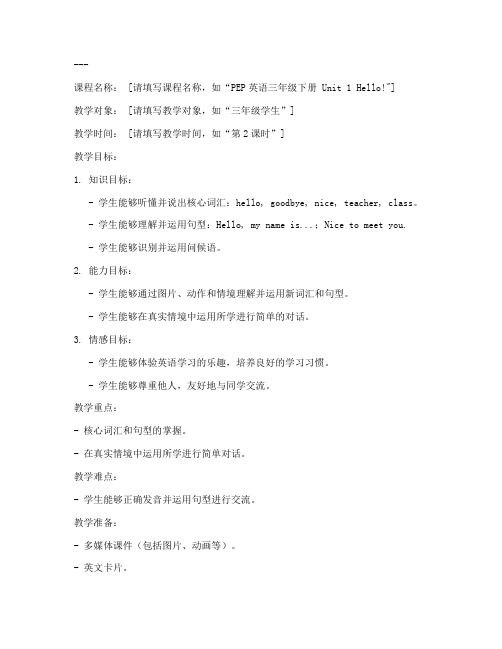
---课程名称: [请填写课程名称,如“PEP英语三年级下册 Unit 1 Hello!"]教学对象: [请填写教学对象,如“三年级学生”]教学时间: [请填写教学时间,如“第2课时”]教学目标:1. 知识目标:- 学生能够听懂并说出核心词汇:hello, goodbye, nice, teacher, class。
- 学生能够理解并运用句型:Hello, my name is...;Nice to meet you.- 学生能够识别并运用问候语。
2. 能力目标:- 学生能够通过图片、动作和情境理解并运用新词汇和句型。
- 学生能够在真实情境中运用所学进行简单的对话。
3. 情感目标:- 学生能够体验英语学习的乐趣,培养良好的学习习惯。
- 学生能够尊重他人,友好地与同学交流。
教学重点:- 核心词汇和句型的掌握。
- 在真实情境中运用所学进行简单对话。
教学难点:- 学生能够正确发音并运用句型进行交流。
教学准备:- 多媒体课件(包括图片、动画等)。
- 英文卡片。
- 英语歌曲。
---教学过程:一、导入(5分钟)1. 播放英语歌曲《Hello》,让学生跟随歌曲唱出“Hello”。
2. 教师与学生用简单的英语问候,如“Hello, how are you?”,引导学生进入英语学习氛围。
二、新授(15分钟)1. 词汇教学:- 展示图片,如“Hello”,引导学生说出单词。
- 通过卡片游戏,让学生反复练习词汇。
2. 句型教学:- 教师示范句型“Hello, my name is...”,学生跟读。
- 学生两人一组,互相练习句型。
3. 情景教学:- 创设情境,如上学、放学等,让学生运用所学句型进行对话。
三、练习(15分钟)1. 小组活动:- 将学生分成小组,每组选择一个场景,运用所学句型进行角色扮演。
2. 游戏活动:- 猜单词游戏,教师说出一个单词,学生通过动作或图片猜测单词。
四、巩固(10分钟)1. 单词接龙:- 学生依次说出一个单词,下一个单词的首字母与前一个单词的尾字母相同。
小学英语教案万能模板
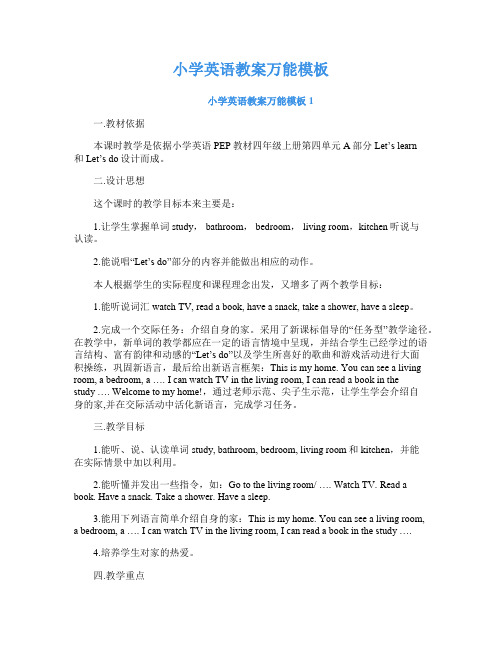
小学英语教案万能模板小学英语教案万能模板1一.教材依据本课时教学是依据小学英语PEP教材四年级上册第四单元A部分Let’s learn和Let’s do设计而成。
二.设计思想这个课时的教学目标本来主要是:1.让学生掌握单词study, bathroom, bedroom, living room,kitchen听说与认读。
2.能说唱“Let’s do”部分的内容并能做出相应的动作。
本人根据学生的实际程度和课程理念出发,又增多了两个教学目标:1.能听说词汇watch TV, read a book, have a snack, take a shower, have a sleep。
2.完成一个交际任务:介绍自身的家。
采用了新课标倡导的“任务型”教学途径。
在教学中,新单词的教学都应在一定的语言情境中呈现,并结合学生已经学过的语言结构、富有韵律和动感的“Let’s do”以及学生所喜好的歌曲和游戏活动进行大面积操练,巩固新语言,最后给出新语言框架:This is my home. You can see a living room, a bedroom, a …. I can watch TV in the living room, I can read a book in thestudy …. Welcome to my home!,通过老师示范、尖子生示范,让学生学会介绍自身的家,并在交际活动中活化新语言,完成学习任务。
三.教学目标1.能听、说、认读单词study, bathroom, bedroom, living room和kitchen,并能在实际情景中加以利用。
2.能听懂并发出一些指令,如:Go to the living room/ …. Watch TV. Read a book. Have a snack. Take a shower. Have a sleep.3.能用下列语言简单介绍自身的家:This is my home. You can see a living room,a bedroom, a …. I can watch TV in the living room, I can read a book in the study ….4.培养学生对家的热爱。
小学英语教案模板范例
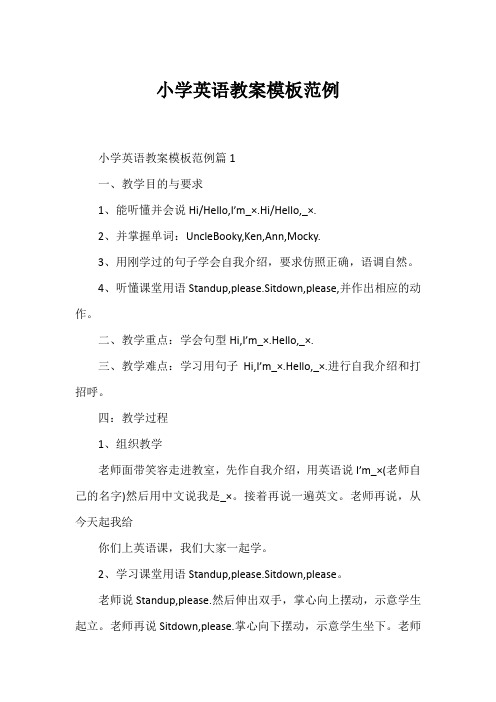
小学英语教案模板范例小学英语教案模板范例篇1一、教学目的与要求1、能听懂并会说Hi/Hello,I’m_×.Hi/Hello,_×.2、并掌握单词:UncleBooky,Ken,Ann,Mocky.3、用刚学过的句子学会自我介绍,要求仿照正确,语调自然。
4、听懂课堂用语Standup,please.Sitdown,please,并作出相应的动作。
二、教学重点:学会句型Hi,I’m_×.Hello,_×.三、教学难点:学习用句子Hi,I’m_×.Hello,_×.进行自我介绍和打招呼。
四:教学过程1、组织教学老师面带笑容走进教室,先作自我介绍,用英语说I’m_×(老师自己的名字)然后用中文说我是_×。
接着再说一遍英文。
老师再说,从今天起我给你们上英语课,我们大家一起学。
2、学习课堂用语Standup,please.Sitdown,please。
老师说Standup,please.然后伸出双手,掌心向上摆动,示意学生起立。
老师再说Sitdown,please.掌心向下摆动,示意学生坐下。
老师走到学生当中,边说边示意。
全班学生做,小组做,最后抽查个别学生做。
接着,老师又站回讲台前,再慢速而准确地说一遍,让学生注意老师发音的口型。
3、学习单词Uncle学习用句型Hi,I’m_×.Hello,_×.进行对话。
(1)老师在讲台前作示范,带表情和手势。
要求学生注意看老师发音的口型和表情。
(2)老师再说I’m_×(老师自己的名字)。
注意夸大口型发出I’m的音给学生听。
让学生仿照发音。
告诉学生意思是“我是”。
让学生在后面接上自己的姓和名,表示“我是_×。
”(3)老师带领学生反复练习I’m的发音。
在基本掌握后,再带领学生操练这个句型,让学生在I’m后面说出自己的名字。
练习两遍后老师在黑板上写出Hi,I’m??这个句型,再教学生读Hi,告诉他们是“喂”的意思。
- 1、下载文档前请自行甄别文档内容的完整性,平台不提供额外的编辑、内容补充、找答案等附加服务。
- 2、"仅部分预览"的文档,不可在线预览部分如存在完整性等问题,可反馈申请退款(可完整预览的文档不适用该条件!)。
- 3、如文档侵犯您的权益,请联系客服反馈,我们会尽快为您处理(人工客服工作时间:9:00-18:30)。
小学英语教案格式l 教学内容分析(Analysis of the teaching contents):l 学生分析(Analysis of the students):l 教学目标(Objectives)1.语言知识目标(Language knowledge):2.语言技能目标(Language skills):3.情感态度目标(sentiment):4.学习策略目标(Learning strategy):5.文化意识目标(Cultural consciousness):(不一定每课写)l 教具(Teaching Aims):l 教学过程(可按实际情况写,每步骤后写目的):一、热身准备(Warming –up):二、呈现与操练(Presentation and practice):三、巩固(Consolidation)四、发展(Development)五、作业(Homework):l 板书设计:l 附上练习:小学英语教案格式2l 教学内容分析(Analysis of the teaching contents):l 学生分析(Analysis of the students):l 教学目标(Objectives)1语言知识目标(Language knowledge):2语言技能目标(Language skills):3情感态度目标(sentiment):4学习策略目标(Learning strategy):5文化意识目标(Cultural consciousness):(不一定每课有)l 教具(Teaching Aims):l 教学过程(Teaching Procedure)(用表格式列出教学步骤、老师的活动、学生的活动以及l 板书设计:l 附上教师在堂上设计的练习或小诗:案例1广州市小学英语教研会英语研讨课教案广州市小学英语课本五年级下册SUCCESS WITH ENGLISHUNIT13---I Prefer Hamburgers荔湾区环翠园小学周乐君Contents:This is the first period of Unit 13. The pupils have learned some words about food and drinks.Analysis of the students:The pupils in Grade 5 can use some simple sentences to talk about the food and drinks they like. In this class, they will learn more about their eating habits.Teaching aims:1. Language knowledge1) To know the new words: prefer, inside, full (pizza, hamburger)2) To know and be able to use the following sentence patterns:A) Which do you prefer, hamburgers or pizza?B) … is / are more delicious than ….C) I like …best.2. Language skills1) To learn some new words and use them in communication.2) To learn some sentence patterns and use them in communication.3) To learn how to ask about choice and express preference.3. SentimentEnjoy talking about eating habits with friends4. Learning strategyTry to understand the language knowledge in the simulated situation.5. Cultural consciousnessTo know the differences between Chinese and the occidental eating habits.Main points:Use the language knowledge in communication.Difficult points:Understanding and using the sentence patterns:Which do you prefer, … or …?I prefer….… is/are more delicious than…Teaching aids: multimedia, pictures, coupons and so on.Teaching Procedures:1. Preparation1) Free talk—Which food do you like?2) A rhyme— Who stole the cookies from the cookie jar?3) Create a simulated situation and let the pupils talk about the food in groups.(教师通过营造气氛,引导学生复习单词,创设模拟真实的情景,让学生在情景中运用英语进行小组对话。
学生围坐在几个小组中,在小组活动中复习单词及句型)2. Presentation1. Learning new words: hamburger, pizza.2. Present the dialogue.3. Ask some questions.4. Make the menu.5. Learn the main points and solve the difficult points of this dialogue.(1) Learn the word “inside”.(2) Learn the sentence patterns:Which do you prefer, … or …?I prefer ….… are more delicious than ….(3) Learn the word “prefer”.(4) Exercises for using the sentence patterns.Which do you prefer, …or…?I prefer….… is/are more delicious than …(5) Report.(6) Look at page 58, listen and repeat.(7) Learn the word “full”.(教师在这个环节里通过教具及多媒体课件对对话及其重点难点进行教学。
学生通过回答问题、制作菜单及与伙伴对话等活动学习生词及课文对话。
)3. Consolidation1) Read the dialogue in your groups. Read in roles2) Recite the whole dialogue with some keywords.3) Act out the dialogue.4) Make your own dialogue.5) Song--E verybody’s hungry.(教师通过引导学生读、背课文,使学生进一步了解和记忆课文,然后鼓励他们自编、自导、自演对话,让所学的知识转变成为真实交际的能力。
学生在小组的练习活动中熟悉课文对话,并加入到表演对话的行列中,发挥自己的创造力,在交际中运用语言。
)4. Development1) Activity--Sell the food or drinks.2) Activity—Talk about the food on the desk and share them with friends.3) Self-assessment.(教师设计了开放性的游戏活动,使孩子们在“乐中学、学中乐”。
学生通过这两个活动及评价增强了学习的兴趣和自信,在交际中灵活运用语言。
)5. Homework1) Copy the new words and recite the dialogue.2) Make your own menu and talk about it with your friends after class.案例2广州市小学六年级《拓展阅读》—“Iceland”教学设计广州市荔湾区环市西路小学张勤一.教学内容分析这篇阅读材料选自Success with English《拓展阅读》中Unit 7的第一篇, 文章中有较多关于冰岛地理概况的材料, 是学生巩固第七单元和拓展视野的材料。
二.学生情况分析六年级学生通过将近四年的英语学习,已经学习了一定数量的词汇、句型和语法的语言知识, 也初步掌握了一些阅读的基本技能。
三.教学目标1. 技能目标:能借助图片读懂简单的短文,并掌握快速阅读的方法。
2. 知识目标:巩固所学过的关于季节、天气、温度等词语与句子, 并能用所学内容谈论天气。
3. 情感态度目标:乐于阅读英语短文。
4. 学习策略:通过小组合作共同完成任务,尝试运用所学技能进行阅读的拓展,并积极与人交流。
5. 文化意识:了解冰岛的地理概况。
四.教学重、难点让学生掌握一定的阅读技巧,并能用所学的方法进行阅读。
五.教学过程Ⅰ. Pre-reading1. Free talk: about today’s weather.2. Ask the students to sing the song:“Changing Seasons”(From Magic English)(通过简短的free talk 使师生间的气氛更融洽, 而英语歌曲的演唱帮助学生更快的进入角色。
)3. Ask students to look at the screen to revise some words about weather and seasons.(Present by courseware.)(通过mind-map帮助学生回忆、复习所学过的关于seasons和weather的单词,为以下的阅读教学做准备。
)4. Leading-in:1) Make a situation to present “Iceland” by saying:“We’re going to have a seven-day holiday in May. And we’re going to visit an interesting co untry—Iceland.”(Present some pictures about Iceland by courseware.)(学生对Iceland是很陌生的,但是通过对Iceland的风景图片的欣赏,使学生对Iceland有了初步的认识,并且从视觉上引起对教学内容的兴趣,为接下来的教学打下基础。
